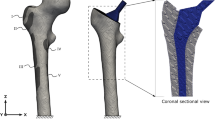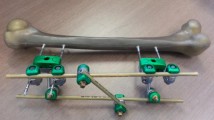Abstract
The insertion of an implant into a bone leads to stress/strain redistribution, hence bone remodeling occurs adjacent to the implant. The study of the bone remodeling around the osseointegration implants can predict the long-term clinical success of the implant. The clinical medial–lateral X-rays of 11 patients were reviewed. To eliminate geometrical distortion of different X-rays, they were converted into a digital format and geometrical correction was carried out. Furthermore, the finite element (FE) method was used to investigate how the bone remodeling was affected by the stress/strain distribution in the femur. The review of clinical X-rays showed cortical bone growth around the proximal end of the implant and absorbtion at the distal end of the femur. The FE simulation revealed the stress/strain distribution in the femur of a selected patient. This provided a biomechanical interpretation of the bone remodeling. The existing bone remodeling theories such as minimal strain and strain rate theories were unable to offer satisfactory explanation for the cortical bone growth at the implant side of the proximal femur, where the stress/strain level was much lower than the one in the intact side of the femur. The study established the correlation between stress/strain distribution obtained from FE simulations and the bone remodeling of the clinical review. The cortical bone growth was initiated by the stress/strain gradient in the bone. Through the review of clinical X-rays and FE simulations, the study confirmed that the bone remodeling in a femur with an implant was influenced by the stress/strain redistribution. The strain level and stress gradient hypothesis is presented to offer an explanation for the implanted cortical bone remodeling observed in this study.







Similar content being viewed by others
References
Baumann J. U., Schar A., Meier G. 1992, Reaction forces and moments at hip and knee Orthopade 21(1):29–34
Baumgartner, A., and C. Mattheck, Computer simulation of the remodelling of trabecular bone. In: Computers in Biomedicine, edited by K. D. Held, C. A. Brebbia, and R. D. Ciskowski. Southampton: Computational Mechanics Publications, 1991, pp. 291–296.
Burger E. H., Klein-Nulend J., Smit T. H. 2003, Strain-derived canalicular fluid flow regulates osteoclast activity in a remodeling osteon—a proposal. J. Biomech. 36(10):1453–1459
Carter D. R., Van der Meulen M. C. H., Beaupre G. S. 1996, Mechanical factors in bone growth and development. Bone 18(1):S5–S10
Collet P., Uebelhart D., Vico L., Moro L., Hartmann D., Roth M., Alexandre C. 1997, Effects of 1-and 6-month spaceflight on bone mass and biochemistry in two human. Bone 20(6):547–551
Cowin S. C., 1990, Bone Mechanics. CRC Press, Boca Raton, Florida
Doblaré M., García J. 2001, Application of an anisotropic bone-remodeling model based on a damage-repair theory to the analysis of the proximal femur before and after total hip replacement. J. Biomech. 34(9):1157–1170
Fischer K. J., Jacobs C. R., Levenston M. E., Carter D. R. 1997, Observations of convergence and uniqueness of node-based bone remodeling simulations. Annl. Biomed. Eng. 25(2):261–268
Hazelwood S. J., Martin R. B., Rashid M. M., Rodrigo J. J. 2001, A mechanistic model for the internal bone remodeling exhibits different dynamic responses in disuse and overload. J. Biomech. 34:299–308
Huiskes, R. Biomechanics of bone implant interactions. In: Frontiers of Biomechanics, edited by S. Schmid. Springer-Verlag, New York, 1986
Kerner J., Huiskes R., van Lenthe G. H., Weinans H., van Rietbergen B., Engh C. A., Amis A. A. 1999, Correlation between pre-operative periprosthetic bone density and post-operative bone loss in THA can be explained by strain-adaptive remodeling. J. Biomech. 32(7):695–703
Kowalk D. L., Duncan J. A., Vaughan C. L. 1996, Abduction-adduction moments at the knee during stair ascent and descent. J. Biomech. 29(3):383–388
Kufahl R. H., S. Saha 1990, A theoretical-model for stress-generated fluid-flow in the canaliculi lagunae network in bone tissue. J. Biomech. 23(2):171–180
Mattheck, C., and H. Huber-Betzer. CAO: computer simulation of adaptive growth in bones and trees. In: Computers in Biomedicine, edited by K. D. Held, C. A. Brebbia, and R. D. Ciskowski. Southampton: Computational Mechanics Publications, 1991, pp. 243–252
Nishimura Y., Fukuoka H., Kiriyama M., Suzuki Y., Oyama K., Ikawa S., Higurashi M., Gunji A. 1994, Bone turnover and calcium metabolism during 20 days bed rest in young healthy males and females. Acta Physiol. Scand. 150(S616):27–35
Prendergast P., Taylor D. 1994, Prediction of bone adaptation using damage accumulation. J. Biomech. 27(8):1067–1076
Rubin, C. T., and L. E. Lanyon. Biological Modulation of Mechanical Influences in Bone Remodeling. In: Biomechanics of Diarthroidal Joints, edited by V. C. Mow. New York: Springer-Verlag, 1990
Stülpner M. A., Reddy B. D., Starke G. R., Spirakis A. 1997, A three-dimensional finite analysis of adaptive remodeling in the proximal femur. J. Biomech. 30(10):1063–1066
Sullivan J., Uden M., Robinson K. P., Sooriakumaran S. 2003, Rehabilitation of the trans-femoral amputee with an osseointegrated prosthesis: the United Kingdom experience. Prosthet. Orthot. Int. 27(2):114–120
Tsubota K., Adachi T., Tomita Y. 2002, Functional adaptation of cancellous bone in human proximal femur predicted by trabecular surface remodeling simulation toward uniform stress state. J. Biomech., 35(12):1541–1551
Turner C. H., Anne V., Pidaparti R. 1997, A uniform strain criterion for trabecular bone adaptation: Do continuum-level strain gradients drive adaptation. J. Biomech. 30(6):555–563
Weinans H., Huiskes R., Grootenboer H. J. 1992, The behavoir of adaptive bone-remodeling simulation models. J. Biomech. 25:1425–1441
Xu, W., A. Crocombe, and S. Hughes. Finite element analysis of bone stress and strain around a distal osseointegrated implant for prosthetic limb attachment. Proc. Inst. Mech. Eng. H J. Eng. Med. 214:595–602, 2000
Author information
Authors and Affiliations
Corresponding author
Rights and permissions
About this article
Cite this article
Xu, W., Robinson, K. X-Ray Image Review of the Bone Remodeling Around an Osseointegrated Trans-femoral Implant and a Finite Element Simulation Case Study. Ann Biomed Eng 36, 435–443 (2008). https://doi.org/10.1007/s10439-007-9430-7
Received:
Accepted:
Published:
Issue Date:
DOI: https://doi.org/10.1007/s10439-007-9430-7




